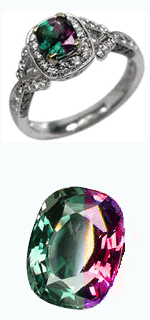| Colors: |
Alexandrite is green or bluish-green in daylight, changing to raspberry red or purplish-red in incandescent light. Because of its color change, alexandrite has sometimes been referred to as emerald by day and ruby by night. The more distinct the change of colour, the more valuable the stone. A fine alexandrite should show a vivid bluish-green in daylight and a purplish-red in artificial light, without any trace of undesirable brown or grey. |
| Shapes: |
Available in a variety of shapes, usually oval. |
| Origin: |
Russia, Brazil, Sri Lanka, Zimbabwe & Tanzania. Very Limited Quantities. |
| Care: |
Alexandrite is hard, tough, and durable enough for daily wear. It requires no special or unusual care. |
| Notes: |
This extremely rare gemstone owes it's name to the fact that it was first discovered in the Urals in 1830, on the day of Prince Alexander's of Russia's coming of age. The few people who have seen one have marveled at it's beauty & luster. Because of it's rarity, Alexandrite is a collectors item. |

